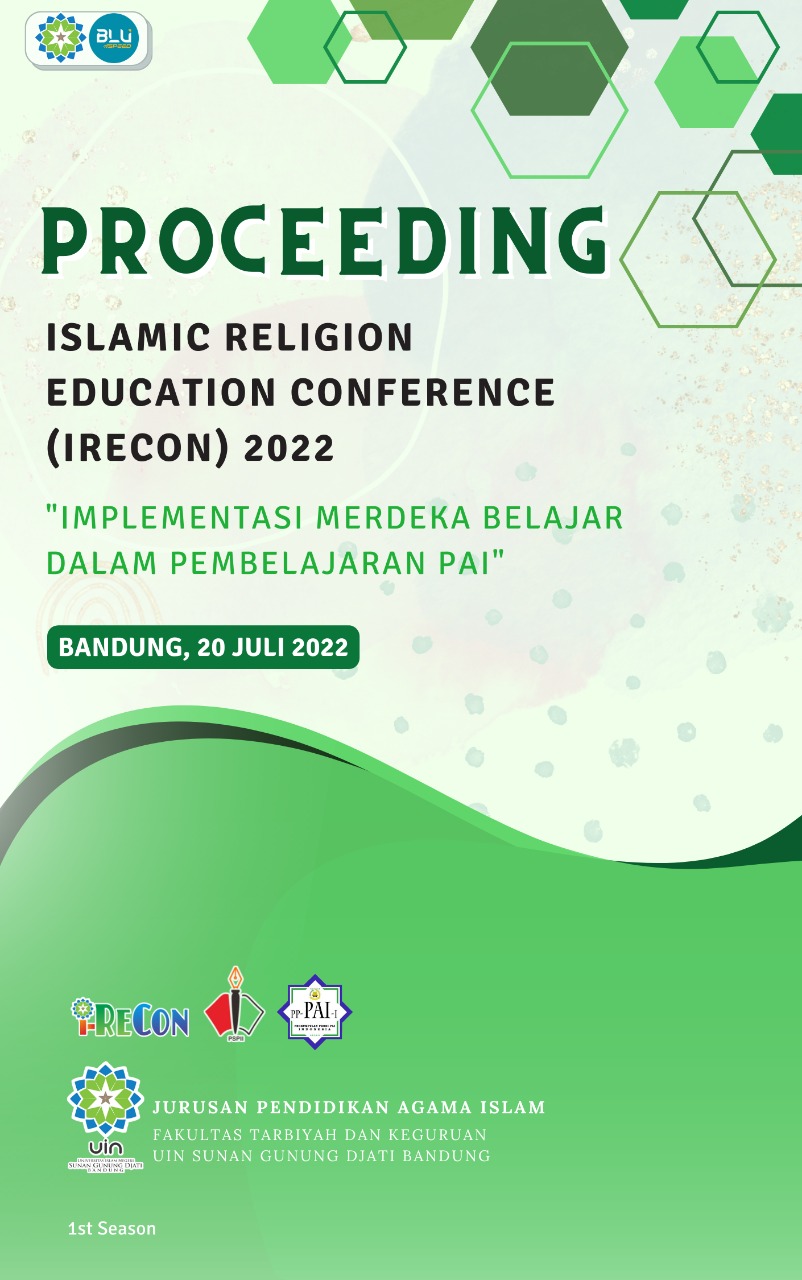Tanggapan Siswa Terhadap Penerapan Program Pembiasaan Hubungannya Dengan Kemampuan Mereka Dalam Membaca Al-Qur’an
Abstract
The purpose of this study was to determine: the reality of student responses to the application of the habituation program, the reality of students' ability to read the Qur'an, the reality of the relationship between students' responses to the application of the habituation program and their ability to read the Qur'an. This study uses a quantitative approach with a correlational method. Respondents are students of class VIII at SMPN 1 Cileunyi totaling 50 people. The data collection techniques used are; questionnaires, tests, observations, interviews and document studies. The data analysis techniques used are; partial analysis, normality test, regression test, correlation test and hypothesis testing. Based on the results of the study, conclusions were obtained: 1) The reality of student responses to the application of the habituation program was included in the very positive category. the average value is 4.45. This figure is in the interval 4.20 – 5.00 which means it has a very positive category. 2) The reality of students' ability to read the Qur'an is included in the sufficient category. The average value taken is 66.0. This number is in the 60-69 interval which means it has a sufficient category. 3) Reality The relationship between students' responses to the application of the habituation program (Variable X) with their ability to read the Qur'an (Variable Y) is included in a positive and significant correlation. This is based on the Spearman rank correlation test, the results show a value of 0.01% which is in the interval 0.00 0.99, which means it is categorized into a positive correlation. Based on the attached hypothesis test, it can be seen that (-0.01) < (0.279) then is rejected and 0 is accepted. The correlation used follows the linear regression equation model Y= 59.13 + 0.0077. Based on the equation, it can be seen that the (+) sign indicates an increase or increase in students' ability to read the Qur'an. The coefficient of determination reaches 1% and the remaining 99% is influenced by other factors.
Downloads
References
Hermawan, I. (2019). Metodologi Penelitian Pendidikan (Kualitatif, Kuantitatif dan Mixed Method).
Hidayatul Quran. Apipah, D. A. (2019). Tanggapan santri terhadap pelaksanaan diskusi bulanan pesantren hubungannya dengan motivasi belajar; Penelitian pada Santriwan dan Santriwati pondok pesantren Salafiyah Al-Mu'awanah Cibiru Wetan Kec Cileunyi Kab. Bandung (Doctoral dissertation, UIN Sunan Gunung Djati Bandung).
Ni'mah, L. M., & Ula, M. (2015).Pengaruh Metode Pembiasaan Membaca AlQur'an Terhadap Kemampuan Menghafal Surat-Surat Pendek Siswa MTsN Petarukan Kabupaten Pemalang. Rohmi, M. (2016).Implementasi metode pembiasaan membaca Al-Qur’an selama 15 menit sebelum KBM dimulai bagi siswa di Madrasah Aliyah Negeri II Jember (Doctoral dissertation, Universitas Islam Negeri Maulana Malik Ibrahim).
Mutakin, T. Z. (2014). Penerapan teori pembiasaan dalam pembentukan karakter religi siswa di tingkat sekolah dasar. Edutech, 13(3), 361-373.
Ihsani, N., Kurniah, N., & Suprapti, A. (2018).Hubungan metode pembiasaan dalam pembelajaran dengan disiplin anak usia dini. Jurnal Ilmiah Potensia, 3(2), 105-110.
Afandi, M., Chamalah, E., Wardani, O. P., & Gunarto, H. (2013). Model dan metode pembelajaran. Semarang: Unissula. Sudrajat, A. (2008). Pengertian pendekatan, strategi, metode, teknik, taktik, dan model pembelajaran. Nurhayati, T., Nurunnisa, E. C., & Husni, H. (2018). UPAYA MENINGKATKAN KEMAMPUAN MEMBACA AL-QUR’AN ANAK USIA DINI MELALUI PENERAPAN METODE IQRA’ (Penelitian Tindakan Kelas di Raudhatul Athfal 59 Daarul Hikmah Kecamatan Cijeungjing Kabupaten Ciamis). Tarbiyat al-Aulad: Jurnal Pendidikan Islam Anak Usia Dini, 3(1).
Jaedun, A. (2011). Metodologi penelitian eksperimen. Fakultas Teknik UNY, 12. Abdurohim, U. L. (2016). pedoman ilmu tajwid lengkap. Bandung: CV penerbit Diponegoro.
Ali, M. (1985). Penelitian Kependidikan: Prosedur dan Strategi. Bandung: Angkasa. Arikunto, p. (2014). PROSEDUR PENELITIAN. jakarta: rineka cipta. Arikunto, S. (2002). Prosedur Penelitian Suatu Pendekatan Praktek. Jakarta: Rineka Cipta. Azwar, S. (1998). Metode Penelitian. Yogyakarta: Pustaka Pelajar. Baharudin, A. (2003). Buku pegangan santri kelas 1 dan Ext. tangerang: DAAR EL-QOLAM. Mahmud.(2011). Metode Penelitian Pendidikan. Bandung: Pustaka Setia.
Muliawan, J. U. (2014). Metodologi Penelitian Pendidikan. Yogyakarta: Penerbit Gava Media. Mulyasa. (2013). Psikologi Pendidikan. Bandung: Remaja Rosdakarya. Sardiman. (1992). Interaksi dan Motivasi Belajar. Jakarta: Rajawali Pers. Sukandarrumidi. (2012). Metodologi Penelitian. Yogyakarta: Gadjah Mada University Press.
Surahkhamat, W. (1980). Psikologi Pemula. Bandung: Jenmart.
Ujang Dedih, Q. Y. (2019). PERHATIAN ORANG TUA DALAM PENDIDIKAN KEAGAMAAN ANAK DI RUMAH HUBUNGANNYA DENGAN PERILAKU MEREKA DI. atthulab, 4-5.
utku, A. (2020). the effect of critical reading skill on academic success in social students. eurasian journal of educational research, 322.
Yusuf, A. M. (2017). Metode Penelitian Kuantitatif, Kualitatif & Penelitian Gabungan. Jakarta: Prenada Media.




